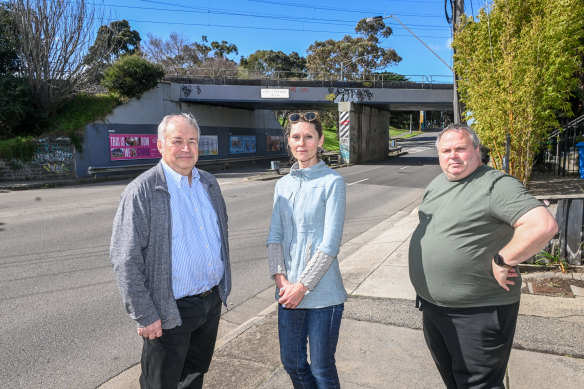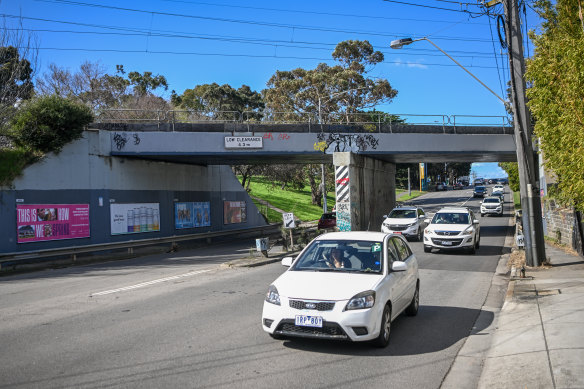By Adam Carey
A plan to narrow one of the busiest roads in bayside Melbourne to make space for a two-way bike lane and wider footpaths has sparked a fight over the future of a suburb that is forecast to squeeze in an extra 32,000 people.
Bay Road carries tens of thousands of vehicles a day between Sandringham Beach and Southland shopping centre in Cheltenham.
Four lanes wide for most of its four-kilometre length, the east-west arterial will be narrowed to three lanes where it passes through central Cheltenham, a low-rise middle-ring suburb where Australia’s most expensive train tunnel will terminate.

Doug Klein, Bayside City Council mayor Fiona Stitfold, and Derek Screen, stand on the side of Bay Road, which has two competing visions for its future.Credit: Justin McManus
Cheltenham, about 20 kilometres south-east of Melbourne’s CBD, is set to be transformed by the state Labor government’s $35 billion Suburban Rail Loop project.
Apartment buildings up to 18 storeys tall will be constructed above the future station, and up to 10 storeys tall along Bay Road, according to plans published by the Suburban Rail Loop Authority. The area’s population will swell from about 20,500 people to more than 52,000 by 2050.
The Allan government has seized planning control in Cheltenham, as it has with the rail loop’s five other station precincts, and wants to rid the area of its overwhelming car dependency.
Just 6 per cent of trips through central Cheltenham are by public transport, walking or cycling, according to modelling for the project.
“Cyclists generally share road space with high-speed general traffic, or they use the footpaths,” the authority’s environment impact assessment states.
To help change this, Bay Road will be transformed from a car-dominated road that is hostile to bikes to the precinct’s “main axis … with wide pedestrian footpaths, separated cycle paths and green street-scaping to create a vibrant street frontage”.
But Bayside City Council has expressed dismay at the authority’s vision for Cheltenham, which it argues would erase the neighbourhood’s existing low-rise suburban character.
It warns that any narrowing of Bay Road risks creating gridlock on the area’s most important east-west road, and pushing cars and trucks to rat-run down local streets.

The Bayside City Council wants to see Bay Road widened to four lanes along its entire length. Credit: Justin McManus
The council has told the authority that it “strongly opposes” any narrowing of Bay Road. Rather, it wants to see the road widened to at least two lanes along its entire length, including at the ageing rail bridge. It has proposed creating an east-west bike route on quieter streets.
Bayside Mayor Fiona Stitfold said the authority’s proposal to direct cyclists along Bay Road was dangerous and ignored the council’s own well-advanced cycling plan.
Proposals for 18-storey buildings in central Cheltenham and 10-storey buildings on Bay Road were also an unreasonable increase in housing density, she said.
“The council is supportive of additional public transport and pedestrian activity, and people having the ability to use greener forms of transport, but we also need to make sure that that area’s amenity is being protected and that the community is being listened to,” Stitfold said.
The council is pushing for more modest building heights of four to eight storeys on Bay Road and has sought to recruit locals to its campaign against the radical change proposed for Cheltenham.
In June, it placed posters around the area, warning residents of the scale of change the community can expect once the underground station is built.
“Your area could be impacted by proposed planning changes from the Suburban Rail Loop project. This includes increased housing density, traffic congestion and a squeeze on open space and infrastructure,” the posters stated, urging people to submit their views to the Suburban Rail Loop Authority.
Local Doug Klein, a member of community group the Highett Progress Association, lives one street north of Bay Road, and could see 10-storey buildings at his back fence under the proposal. Klein said the scale of development proposed around the station was alarming.
“Development has to happen. Yes, we need infill. You can’t keep sprawling out into the suburbs, but you’ve got to think about how you do it and make sure it’s well planned, and you’ve got setbacks and suitable amenities. And at the moment, the whole SRL thing is very scary for a lot of people,” he said.
Pennydale Residents Action Group president Derek Screen said Bay Road passed the Bayside Business Centre, the municipality’s only employment zone.
“Changing Bay Road would have a severe impact not only for residents, but for businesses,” he said.
Stage one of the Suburban Rail Loop, with six underground stations between Cheltenham and Box Hill, is planned to have trains running by 2035. An authority spokesperson said nearly 8000 passengers a day were expected to use the new station at Cheltenham, and it’s important all of them have safe and easy access.
“The proposed change is backed by extensive traffic modelling, supported by independent experts and has been endorsed by the Independent Advisory Committee because it is the best outcome for the safety of the community as well as pedestrians and cyclists,” the spokesperson said.
“Melbourne needs more public transport and more homes, and the Suburban Rail Loop will deliver both, and we’ll keep working with council and residents to carefully plan for the future of Cheltenham.”
The University of Melbourne’s Dr Crystal Legacy said it was inevitable that Cheltenham would have to pedestrianise its streets to meet such a large population increase but said it was reasonable to ask where the traffic on Bay Road will go.
“The SRLA need to have an answer for that,” she said.
Community resistance to the Suburban Rail Loop Authority’s proposals could be attributed to a lack of trust in the state government, which has conveniently discarded planning protocols to push ahead with its “big build”, Legacy said.
“Infrastructure projects like this one have become just very politicised, they have become political footballs and sometimes at the detriment of good planning,” she said.
For the latest results, news and analysis from the Paris Paralympics sign up for our Morning Edition newsletter.